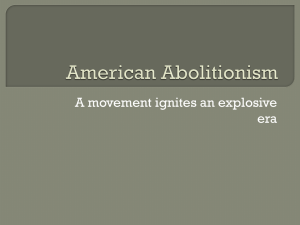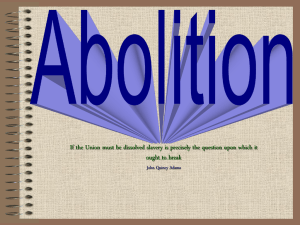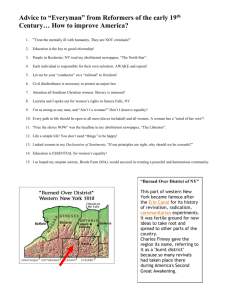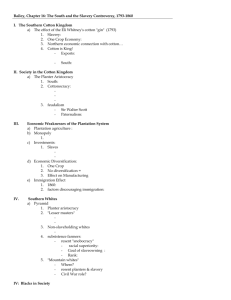Name Chapter 16 The South and the Slavery Controversy True and
advertisement
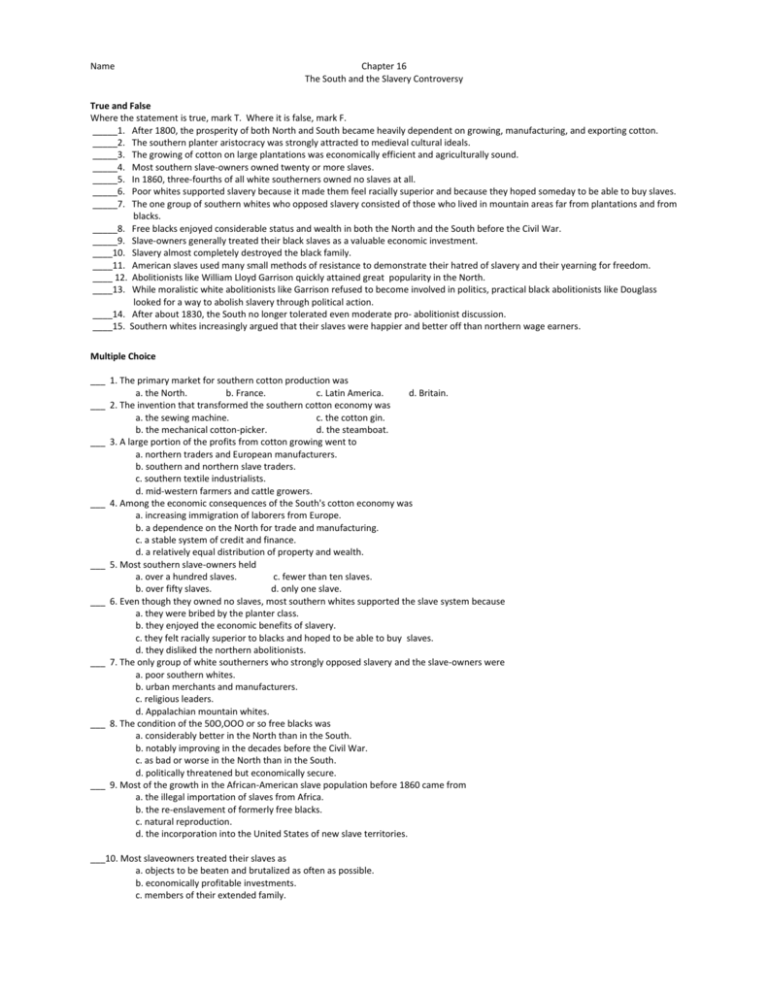
Name Chapter 16 The South and the Slavery Controversy True and False Where the statement is true, mark T. Where it is false, mark F. _____1. After 1800, the prosperity of both North and South became heavily dependent on growing, manufacturing, and exporting cotton. _____2. The southern planter aristocracy was strongly attracted to medieval cultural ideals. _____3. The growing of cotton on large plantations was economically efficient and agriculturally sound. _____4. Most southern slave-owners owned twenty or more slaves. _____5. In 1860, three-fourths of all white southerners owned no slaves at all. _____6. Poor whites supported slavery because it made them feel racially superior and because they hoped someday to be able to buy slaves. _____7. The one group of southern whites who opposed slavery consisted of those who lived in mountain areas far from plantations and from blacks. _____8. Free blacks enjoyed considerable status and wealth in both the North and the South before the Civil War. _____9. Slave-owners generally treated their black slaves as a valuable economic investment. ____10. Slavery almost completely destroyed the black family. ____11. American slaves used many small methods of resistance to demonstrate their hatred of slavery and their yearning for freedom. ____ 12. Abolitionists like William Lloyd Garrison quickly attained great popularity in the North. ____13. While moralistic white abolitionists like Garrison refused to become involved in politics, practical black abolitionists like Douglass looked for a way to abolish slavery through political action. ____14. After about 1830, the South no longer tolerated even moderate pro- abolitionist discussion. ____15. Southern whites increasingly argued that their slaves were happier and better off than northern wage earners. Multiple Choice ___ 1. The primary market for southern cotton production was a. the North. b. France. c. Latin America. d. Britain. ___ 2. The invention that transformed the southern cotton economy was a. the sewing machine. c. the cotton gin. b. the mechanical cotton-picker. d. the steamboat. ___ 3. A large portion of the profits from cotton growing went to a. northern traders and European manufacturers. b. southern and northern slave traders. c. southern textile industrialists. d. mid-western farmers and cattle growers. ___ 4. Among the economic consequences of the South's cotton economy was a. increasing immigration of laborers from Europe. b. a dependence on the North for trade and manufacturing. c. a stable system of credit and finance. d. a relatively equal distribution of property and wealth. ___ 5. Most southern slave-owners held a. over a hundred slaves. c. fewer than ten slaves. b. over fifty slaves. d. only one slave. ___ 6. Even though they owned no slaves, most southern whites supported the slave system because a. they were bribed by the planter class. b. they enjoyed the economic benefits of slavery. c. they felt racially superior to blacks and hoped to be able to buy slaves. d. they disliked the northern abolitionists. ___ 7. The only group of white southerners who strongly opposed slavery and the slave-owners were a. poor southern whites. b. urban merchants and manufacturers. c. religious leaders. d. Appalachian mountain whites. ___ 8. The condition of the 50O,OOO or so free blacks was a. considerably better in the North than in the South. b. notably improving in the decades before the Civil War. c. as bad or worse in the North than in the South. d. politically threatened but economically secure. ___ 9. Most of the growth in the African-American slave population before 1860 came from a. the illegal importation of slaves from Africa. b. the re-enslavement of formerly free blacks. c. natural reproduction. d. the incorporation into the United States of new slave territories. ___10. Most slaveowners treated their slaves as a. objects to be beaten and brutalized as often as possible. b. economically profitable investments. c. members of their extended family. Name Chapter 16 The South and the Slavery Controversy d. sources of technological innovation. ___11. The African-American family under slavery was a. generally stable and supportive. b. almost nonexistent. c. largely female-dominated. d. seldom able to raise children to adulthood. ___12. Most of the early abolitionists were motivated by a. a desire to see an independent black republic in America. b. anger at the negative economic consequences of slavery. c. religious feeling against the "sin" of slavery. d. a philosophical commitment to racial integration. ___13. The most prominent black abolitionist leader was a. Sojourner Truth. b. David Walker. c. William Lloyd Garrison. d. Frederick Douglass. ___14. After 1830, most southerners came to look on slavery as a. a curse on their region. b. a necessary evil. c. a positive good. d. a threat to their social ideals. ___15. By the 1850s, most northerners could be described as a. opposed to slavery but also hostile to immediate abolitionists. b. fervently in favor of immediate abolition. c. sympathetic to white southern arguments in defense of slavery. d. eager to let the slaveholding South break apart the Union. Identification _______________ _______________ _______________ _______________ _______________ _______________ _______________ _______________ 1. Term for the South that emphasized its economic dependence on a single staple product 2. Pro-southern New England textile owners who were economically tied to the southern "lords of the lash" 3. British novelist whose romantic vision of a feudal society made him highly popular in the South 4. The poor, vulnerable group that was the object of prejudice in the North and despised as a "third race" in the South 5. Theodore Dwight Weld's powerful antislavery book 6. The area of the South where most slaves were held, stretching from South Carolina across to Louisiana 7. Organization founded in 1817 to send blacks back to Africa 8. The group of theology students, led by Theodore Dwight Weld, who were ex-pelled for abolitionist activity and later became leading preachers of the antislavery gospel _______________ 9. William Lloyd Garrison's fervent abolitionist newspaper that preached an immediate end to slavery _______________10. Garrisonian abolitionist organization, founded in 1833, that included the eloquent Wendell Phillips among its leaders _______________11. Strict rule passed by pro-southern Congressmen in 1836 to prohibit all discussion of slavery in the House of Representatives _______________12. Northern antislavery politicians, like Abraham Lincoln, who rejected radical abolitionism but sought to prohibit the expansion of slavery in the western territories Matching Cause and Effect ___ 1. Sir Walter Scott ___ 2. Harriet Beecher Stowe ___ 3. Nat Turner ___ 4. Liberia ___ 5. Theodore Dwight Weld ___ 6. Lewis Tappan ___ 7. Lane Theological Seminary ___ 8. William Lloyd Garrison ___ 9. David Walker ___10. Sojourner Truth ___11. Martin Delay ___12. Fredrick Douglas ___13. Virginia Legislature ___ 14. John Quincy Adams ___15. Elijah Lovejoy a. Wealthy New York abolitionist merchant whose home was demolished by a mob in 1834 b. Visionary black preacher whose bloody slave rebellion in 1831 tightened the reins of slavery in the South c. Midwestern institution whose president expelled eighteen students for organizing a debate on slavery d. New York free black woman who fought for emancipation and women’s rights e. Leading radical abolitionist who burned the Constitution as “a covenant with death and an agreement with hell” f. Author of an abolitionist novel that portrayed the separation of slave families by auction g. Site of the last major southern debate over slavery and emancipation, in 1831-2 h. English novelist whose romantic medievalism encouraged the semifeudal ideals of the southern planter aristocracy i. Black abolitionist who visited West Africa in 1859 to examine sites where African Americans might relocate j. Former president who fought for the right to discuss slavery in Congress k. Illinois editor whose death at the hands of a mob made him an abolitionist martyr L. West African republic found in 1822 by freed blacks from the United States Name Chapter 16 The South and the Slavery Controversy m. Escaped slave and great black abolitionist who fought to end slavery through political action n. Black abolitionist writer who called for a bloody end to slavery in an appeal of 1829 o. Leader of the “Lane Rebels” who wrote the powerful antislavery work American Slavery As It Is Putting Things in Order ___ The last slavers to be legally imported from Africa enter the United States ___ A radical abolitionist editor is murdered, and so becomes a martyr to the antislavery cause ___ A radical abolitionist newspaper and a slave rebellion spread fear through the South ___ A new invention increases the efficiency of cotton production, laying the basis for the vast Cotton Kingdom ___ A group of seminary students expelled for their abolitionist views spread the antislavery gospel far and wide Matching Cause and Effect ___ 1. Whitney’s cotton gin and southern a. Often resulted in the cruel separation of black families frontier expansionism b. Kept poor, non-slaveholding whites committed to a system that actually harmed ___ 2. Excessive soil cultivation and them financial speculation c. Aroused deep fears of rebellion and ended rational discussion of slavery in the South ___ 3. Belief in white superiority and the d. Made abolitionists personally unpopular but convinced many Northerners that hope of owning slaves slavery was a threat to American freedom ___ 4. The selling of slaves at auctions e. Caused slaves to work slowly, steal from their masters, and frequently run away ___ 5. The slaves’ love of freedom and hatred f. Stirred a fervent abolitionist commitment to fight the “sin” of slavery of their condition g. Turned the South into a booming one-crop economy where “cotton was King” ___ 6. The religious fervor of the Second h. Opposed Garrison and organized the Liberty party and the Free Soil party Great Awakening i. Created dangerous weaknesses beneath the surface prosperity of the southern ___ 7. Politically minded abolitionists like cotton economy Frederick Douglass j. Widened the moral and political gap between the white South and the rest of the ___ 8. Garrison’s Liberator and Nat Turner ‘s Western world bloody slave rebellion ___ 9. White southern defenses of slavery as a “positive good” ___10. The constant abolitionist agitation in the North


